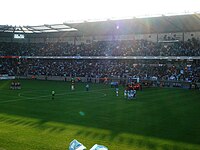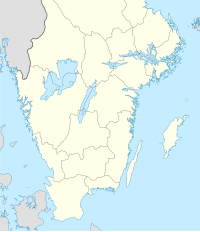The Big Three (Clubs) (Swedish: De tre största (klubbarna)) is a phrase used to refer to the three most successful football clubs in Sweden by authors,[1] journalists,[2][3] club representatives,[4][5] and supporters.[6] The three clubs AIK from Stockholm, IFK Göteborg from Gothenburg, and Malmö FF from Malmö have a combined 50 out of 119 Swedish championship titles, 30 out of 64 Svenska Cupen titles, and occupy the top three places in the All-time Allsvenskan table.
Malmö FF lead the all-time Allsvenskan table, but AIK have played the most seasons in the highest league. The three have led the all-time table for 83 out of 95 seasons, and no other club has led the table since 1937. As for swedish championship titles, the Malmö side have 23, IFK Göteborg have 18, while AIK is trailing with 12 in fourth place, behind IFK Norrköping and their 13 titles. In the national cup, Malmö FF have won 15 times, IFK Göteborg and AIK share the second place with 8 titles each. IFK Göteborg and Malmö FF are the only clubs to have reached the final of a European competition, IFK Göteborg having won the UEFA Cup in 1981–82 and again in 1986–87 while Malmö FF were runners-up in the 1978–79 European Cup.[7]
As IFK Göteborg distanced itself from its old informal alliance, Göteborgsalliansen, with the other Gothenburg clubs in the 1970s, they instead established a closer cooperation with Malmö FF and AIK under the partnership name "The Three Traditional Teams of Sweden" for some time.[8] Football historian Torbjörn Andersson refers to the three clubs as Sweden's three "proper large clubs" ("verkliga storklubbar").[9]
The Swedish football magazine Offside ranked the largest clubs in Sweden in 2010 by defining five categories ("national honours", "international honours", "excellence", "attendance", and "trend") in which AIK ranked 4th, 3rd, 5th, 1st, and 1st, IFK Göteborg ranked 2nd, 1st, 2nd, 2nd, and 3rd, and Malmö FF ranked 1st, 2nd, 1st, 4th, and 2nd.[10] Totalling the scores of each category, Malmö FF ranked first scoring 87 points narrowly beating IFK who scored 85 points, with AIK third at 79 points.[11] The fourth-ranked club Djurgårdens IF scored 60 points in total, the only other club together with IFK Norrköping outside the big three that managed to rank top 3 in any category.[10] AIK, IFK Göteborg and Malmö FF are also the three clubs that have contributed with the most players, as well as the most caps, to the Sweden national team.[12]
Rivalries
editThe fixture between AIK and IFK Göteborg, the two largest clubs from the two largest cities, has been called the "Swedish El Clásico".[13] The two clubs have, besides some Swedish local derbies, the largest rivalry in Swedish football. Fixtures between the clubs gather the largest nationwide interest out of any Swedish club fixtures.[13]
The rivalry between the two most successful clubs in terms of honours, IFK Göteborg and Malmö FF, is sometimes called "Mesta mästarmötet" (English: Clash of the greatest champions).[7]
Honours
edit| Team | Champ[A] | National leagues | National cups | International | |||||
|---|---|---|---|---|---|---|---|---|---|
| AS | MS | SvS | ASPO | SvM | SvC | SvSC | UC | ||
| AIK | 12 | 6 | 1 | 0 | 0 | 6 | 8 | 1 | 0 |
| IFK Göteborg | 18 | 13 | 1 | 5 | 5 | 6 | 8 | 1 | 2 |
| Malmö FF | 23 | 26 | 0 | 0 | 2 | 0 | 15 | 2 | 0 |
- ^ The Swedish football champions have been decided through four different tournaments: Svenska Mästerskapet 1896–1925, Allsvenskan 1931–1981 and 1993–, Allsvenskan play-offs 1982–1990, and Mästerskapsserien 1991–1992. No champions were declared 1926–1930.
See also
editCitations
edit- ^ Nylin 2004, p. 10.
- ^ Flinck 2016.
- ^ Townsend 2009.
- ^ Häll & Paulsson 2014.
- ^ Tillberg 2015.
- ^ Fotbolldirekt 2012.
- ^ a b Smith 2017.
- ^ Andersson 2011, p. 344.
- ^ Andersson 2011, p. 354.
- ^ a b Regnell & Ystén 2010, pp. 66–79.
- ^ Regnell & Ystén 2010, p. 81.
- ^ "Clubs of European national football team players". EU-Football. Retrieved 3 April 2021.
- ^ a b Laul 2015.
References
edit- Andersson, Torbjörn (2011). "Spela fotboll bondjävlar!": en studie i svensk klubbkultur och lokal identitet från 1950 till 2000-talets början (in Swedish). Vol. 1. Stockholm: Symposion. ISBN 978-91-7139-868-0.
- Flinck, Johan (1 April 2016). "Kaxiga löftet: "Vi tar hem det i år"" (in Swedish). Aftonbladet. Retrieved 4 August 2020.
- "…"Förstår inte varför motståndarna gillar oss"" (in Swedish). Fotbolldirekt. 7 November 2012. Retrieved 4 August 2020.
- Häll, Johan; Paulsson, Cecilia (12 November 2014). "Magnus Haglund ny Elfsborgtränare" (in Swedish). SVT. Retrieved 4 August 2020.
- Laul, Robert (21 May 2015). "Laul: En match som berör hela landet" (in Swedish). Aftonbladet. Retrieved 4 August 2020.
- Nylin, Lars (2004). Den nödvändiga boken om Allsvenskan: svensk fotboll från 1896 till idag, statistik, höjdpunkter lag för lag, klassiska bilder (in Swedish). Sundbyberg: Semic. ISBN 91-552-3168-3.
- Regnell, Tobias; Ystén, Henrik (2010). "Störst i Sverige". Offside (in Swedish). No. 2. Göteborg: Offside Press.
- Smith, Rune (31 March 2017). ""Det finns en charm i hatet och tjafset"" (in Swedish). Kvällsposten. Retrieved 4 August 2020.
- Tillberg, Fredrik (4 June 2015). ""Rivaliteten mellan oss och Blåvitt har mer glimt i ögat"" (in Swedish). Fotbolldirekt. Retrieved 4 August 2020.
- Townsend, Nic (2 April 2009). "Swedish football: A beginner's guide to the Allsvenskan". The Local. Retrieved 25 August 2020.



